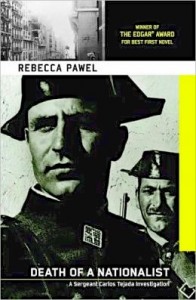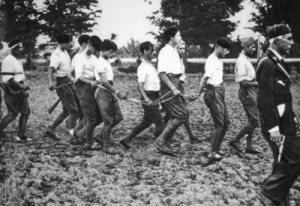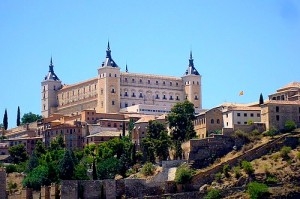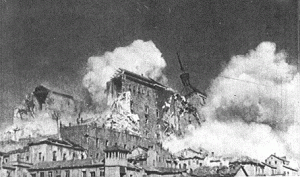Note: This novel was WINNER of the Edgar Award for Best First Novel in 2004. The author was twenty-three, at the time.
“You are a miliciana. Drop that, please,” he added, clamping his hands over the hand that held the battered notebook and grabbing [her] forearm with the other: “Or I’ll break your wrist…Now as I was saying, I don’t think we’re in any doubt as to what you are. But I’d like to know why you were fool enough to come back here after killing a guardia.” –Guardia Civil Sergeant Carlos Tejada Alonso y Leon, Madrid, 1939.
 Setting her novel in 1939, in the immediate aftermath of the Spanish Civil War, author Rebecca C. Pawel carefully recreates many of the elements which led to that civil war and which continued in the partisan turmoil that continued long after that. Sometimes described by Republicans as “a war between tyranny and democracy,” and by Nationalists as “a war between Communists, anarchists, and ‘Red Hordes’ against civilization,” the Spanish Civil War (1936 – 1939) attracted extremists on both sides. The Socialist Republicans were aided by the Soviets, Marxists, and Bolsheviks, while the Nationalists, led by Francisco Franco, were supported by the church, monarchists, fascists, conservatives wanting to preserve their ancient land rights, and eventually by Adolf Hitler and Benito Mussolini. Both sides had committed atrocities against their fellow citizens, leading Franco to set up the Guardia Civil, not the army, to police the cities in the aftermath of war.
Setting her novel in 1939, in the immediate aftermath of the Spanish Civil War, author Rebecca C. Pawel carefully recreates many of the elements which led to that civil war and which continued in the partisan turmoil that continued long after that. Sometimes described by Republicans as “a war between tyranny and democracy,” and by Nationalists as “a war between Communists, anarchists, and ‘Red Hordes’ against civilization,” the Spanish Civil War (1936 – 1939) attracted extremists on both sides. The Socialist Republicans were aided by the Soviets, Marxists, and Bolsheviks, while the Nationalists, led by Francisco Franco, were supported by the church, monarchists, fascists, conservatives wanting to preserve their ancient land rights, and eventually by Adolf Hitler and Benito Mussolini. Both sides had committed atrocities against their fellow citizens, leading Franco to set up the Guardia Civil, not the army, to police the cities in the aftermath of war.

The author holds her statuette of Edgar Allan Poe after winning for Best Debut Novel at the Edgar Awards in 2004
The novel opens quietly in Madrid with Maria Alejandra “Aleja” Palomino, age seven, hurrying home from school. In her Republican neighborhood, however, she sees a guardia acting anxious, and soon afterward she hears shots. Hiding in terror, she later hears another guardia passing her hiding place, humming as he walks. When she eventually dares to head back to the road home, she discovers the first guardia lying dead in a pool of blood. Terrified by what she has witnessed, she drops one of her school notebooks as she races home. Her Republican family comforts her but is more concerned about the missing notebook than with the death of the guardia – paper is extremely valuable, and they have little money for her school supplies. Since Aleja’s Republican neighbors would not be likely to report a dead guardia immediately, her aunt, Tia Viviana, hurries out to retrieve Aleja’s missing book. She is caught picking it up, however, by two guardia who assume she is a Republican “miliciana.” When questioned at the scene, she denies any involvement, insisting she came only for a child’s notebook, but thinking the notebook might contain codes, the guardia kill her, thereby setting the scene for the action to follow.
Because the action, the motivations, and the shifting allegiances are complex here, the author wisely keeps her narrative style simple, moving the action along on the strength of her characters, who are memorable despite the fact that they are somewhat superficial examples of the various factions at work in Madrid at the time. Sgt. Carlos Tejada Alonso y Leon, a mid-level guardia, is widely honored by his fellow officers, having been involved earlier in the Siege of Alcazar in Toledo, a battle in which eight hundred Nationalists, armed only with rifles and machine guns, battled eight thousand Republicans armed with heavy equipment which, ultimately, demolished much of Alcazar Castle. The Nationalists, including Tejada, were eventually liberated by General Franco. Though Tejada sometimes behaves in ways which will be repugnant to readers, the author also depicts him within the confused context of the period. The murdered guardia was his best friend, Francisco Lopez Perez, known as Paco, a man with whom he had lost touch during the war and whose body he had to identify on the street.
The novel alternates between Tejada’s point of view and that of Gonzalo Llorente, the lover of the murdered Viviana, and the brother of Carmen, the child Alexa’s mother. Gonzalo, a Republican, was one of the few to have survived a series of Nationalist executions which killed most of his fellow soldiers, having been the victim of heart problems and a high fever which kept him in the hospital at the time, and he is bent on revenge, not only for the loss of Viviana but for those earlier killings, too. When Gonzalo finds a chocolate wrapper at the scene of the crime, the idea of black marketeering as a motivation is introduced. Most people have too little food to eat, and no one can get luxury items, like real coffee or chocolate except through smugglers for the black market.

Most of the soldiers that Gonzalo knew were executed by Nationalists, a fate about to befall these youths. Note gun in hand of officer on right. Photo from Bridgeman Art Library / Private Collection / Peter Newark Military Pictures.
A minor romance begins between Tejada and Srta. Elena Fernandez, Aleja’s schoolteacher, who is concerned because she realizes that Aleja has witnessed the killing and fears she may be in danger as a witness. Her meeting with Tejada leads to an exchange of information regarding their backgrounds, which is fascinating for the information it provides the reader about how and why people of similar backgrounds and education choose to support different political sides during this confusing period. The violence inherent in an organization like the guardia, which is spread so thin that there appears to be little oversight, makes the reader resent the guardia and their cruelty toward innocent women and children, at the same time that the violence of the Republicans is equally abhorrent.
The conclusion brings all the elements together in a way which is satisfying, though it is a different kind of satisfaction, since one does not really relate to the main characters. A surprise twist provides a sense that not everyone may be as cruel at heart as it appears from the action, though this is also a way for the author to create some much-needed empathy in a book that is otherwise almost devoid of it. Realistic and filled with the kind of details that only someone who has studied all aspects of this war would know, the novel is both a good mystery and an especially readable depiction of an otherwise confusing time of history. It is difficult to believe that an author so young could have accumulated so much detailed knowledge about this war and even more surprising that she could have arranged it so successfully into a nonstop story in which no one is a real hero.
Photos, in order: The author’s photo from the Edgar Awards of 2004 is one of the few available. http://www.lecturalia.com/
The Alcazar of Toledo, beseiged for months in 1936, was rescued by Gen. Francisco Franco. Originally a Roman palace from the 3rd century, it suffered serious damage during the Spanish Civil War. http://www.noviastravel.com/
The damage to the Alcazar is recorded in this photo from http://www.alcazar.net/history.html
Young Republican soldiers being taken to their executions by Nationalist officers, from the Bridgeman Art Library / Private Collection / Peter Newark Military Pictures, available on http://www.magnoliabox.com


